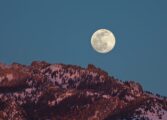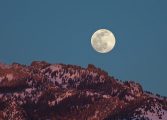By Pat Beers Block
Welcome to this month’s highlights of enjoyable astronomical events that will happen in the evening and morning skies above!
What a month April was this year! With events like the solar eclipse visible in North America, and the return of meteor showers, it seemed like we went on an exotic vacation to places we haven’t been or seen before. Perhaps it’s appropriate that the celestial events of May will be more mundane, giving us time to savor our exotic April universe vacation.
Astronomical events in May are more like the routine tasks we return to after a once in a lifetime vacation- mowing the lawn, putting our vacation treasures in our favorite curios, sorting and e-storing our pictures, and getting back to our day/night jobs.
Provided we don’t have overcast skies- something that has plagued us for the past couple of months- events to look forward to include observing multiple planets, meteor showers, and constellations with interesting star formations.
Speaking of constellations, you will find some of the components of our solar system are assigned numbers, such as Messier 41 (the three stars in Orion’s belt), and Messier 45 (the Seven Sister Star cluster in Taurus) when they are referenced and described. There is a fascinating story behind this numbering system that is truly inspiring to both professional and amateur astronomers as they (and we) search of the sky.
In the 18th century, the French astronomer, Charles Messier, was looking for comets but found other formations that interfered with his search. He decided to make a list of these non-comet objects, a list that became a published catalog that contained objects that were discovered by Messier, as well as other objects discovered by other astronomers. Messier personally discovered 18 of the first 45 objects listed in this catalog (first published in 1774). As time went on, this catalog increased to 103 during Messier’s lifetime, and it identifies 110 numbered objects. These objects include a variety of nebulae (star forming areas), open clusters (star clusters of medium size, all formed around the same time), globular clusters ( spherical, dense concentration of stars ), and galaxies (Messier object – Wikipedia )
This is awe-inspiring in that Messier found objects that didn’t interest him, but still took the time to research their characteristics and document his findings. There are many stories about amateur astronomers who took the time to research an anomaly and made a new discovery through their tenacity. You, too, might find yourself in a situation like this someday in your sky viewing. Remember to take good notes and stick with your intuition that you may have discovered something new!
Let’s get ready for this month’s celestial countdown by getting your star gazing equipment cleaned and set up, your cell phones fully charged to use the Sky Guide or Sky View Lite or any other star gazing applications that you find useful, and your favorite recliner to view the night and early morning sky!
Some fun events that will happen in May 2024 include the following events [extracted from Astronomy Calendar of Celestial Events 2024 – Sea and Sky (seasky.org)’; The Night Sky in April 2024 | Day By Day Astronomy Events (starlust.org) NASA Science Space Place (spaceplace.nasa.gov/eclipses/en/), and StarWalk.space (Astronomy News: Current Astronomy & Stargazing Events | Stargazing Forecast 2023 | Star Walk).
Week 1 (May 1-4)
On the morning of May 4, the waning crescent moon can be found between the planet Saturn (upper right) and Mars (lower left) just above the eastern horizon. The best time to view this event is about one hour before sunrise.
Weeks 2 and 3 (May 5-18)
On May 6-7, the meteor shower Eta Aquarids, will be most visible. Although this is a powerful shower in the southern hemisphere, in Fluvanna County we might find about 30 meteors an hour, provided the sky is clear. With the moon being in its waning crescent phase, there will be no competing light from it to diminish the visibility of planets and constellations that will be within view. This meteor shower is the product of debris emanating from dust particles left by comet Halley.
May 8 produces the new moon, a phase of the moon when the side of the moon that is enlightened by the Sun faces away from the Earth. With the moon located on the same side of the Earth as the Sun, the new moon is not visible to us. This is a good time to see, even without binoculars, star clusters, constellations, and nearby planets.
Looking in the eastern morning sky, slightly above the horizon, just before sunrise, you should see the planet Mercury on May 9. This should be the best time to view the planet Mercury since it is at its greatest western elongation. The term means a planet is the farthest away from the Sun. Since Mercury is the first planet in our Solar System, being away from the Sun gives us the opportunity to see Mercury without being overwhelmed by the Sun’s powerful light.
On May 12, the moon, in its waxing (getting larger) crescent phase, can be seen close to Castor (a cluster of six stars) and the star Pollux which are both located in the Gemini constellation.
On May 15, as the moon moves into its first quarter phase when it appears as a half moon, you will find it close to the star system Regulus (an object with four stars) in the Leo constellation. Regulus is the brightest star system in the Leo constellation and should be easy to see on a clear night.
Week 4 and 5 (May 19-31)
On May 19, the waxing moon will be close to the star Spica, the brightest star in the Virgo constellation, in the evening sky, on May 23, the full moon appears. This moon is also called the Flower Moon because of its appearance at the same time as flowers burst into bloom. Although becoming a full moon in the early morning, we should see its full beauty near the Scorpius constellation later in the evening.
The final event in May is the start of the last quarter moon that can be found on May 31. The moon can be found below the planet Saturn in the early morning sky.
Objects to See Throughout the Month of May
There are several constellations that will be visible throughout spring that may be fun to observe and track. The following constellations can be observed throughout the month of May.
The Constellation Virgo (the Maiden) is represented as a stick figure (graphically as woman with wings holding shafts of wheat) with seven major stars. The brightest star is Spica, located at the bottom of the constellation.
Canes Venatici (the Hunting Dogs) is near Ursa Major (the big dipper is found here) and Ursa Minor (the little dipper is found here), and is supposed to represent two dogs, Asterion and Chara, that hunt the bears Ursa Major and Ursa Minor in the sky.
Coma Berenices (Berenice’s Hair) is a constellation found north of Virgo, south of Canes Venatic, and west of Bootes constellations. Originally this constellation was part of Leo but was renamed after Queen Berenice II, the wife of Ptolemy III of Egypt.
Well, those are some of the highlights for the month of May. Although lackluster compared to April’s celestial events, we can enjoy exploring the sky and become more comfortable with our abilities to identify objects and predict where they might be in the morning and night sky.
Until next month, keep your eyes facing the morning and evening sky to see the wonders of our universe as we Earthlings travel through it!



